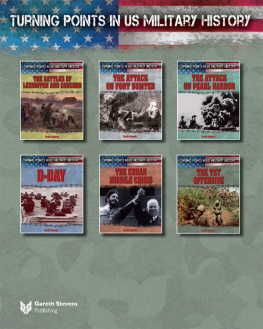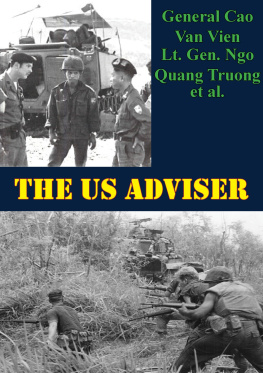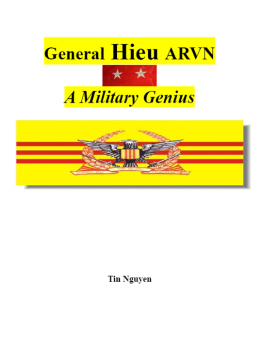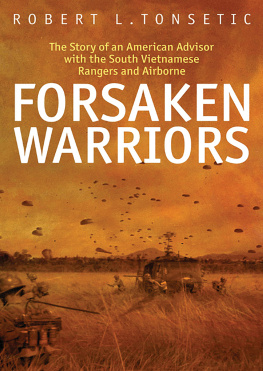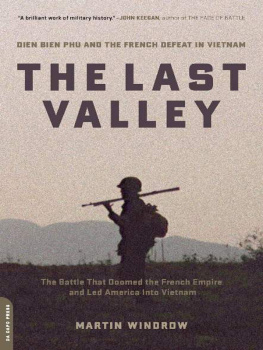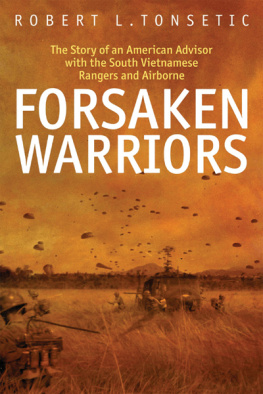ARVN
MODERN WAR STUDIES
Theodore A. Wilson
General Editor
Raymond A. Callahan
J. Garry Clifford
Jacob W. Kipp
Jay Luvaas
Allan R. Millett
Carol Reardon
Dennis Showalter
David R. Stone
Series Editors
ARVN
Life and Death in the
South Vietnamese Army
Robert K. Brigham

University Press of Kansas
2006 by the University Press of Kansas
All rights reserved
Published by the University Press of Kansas (Lawrence, Kansas 66045), which was organized by the Kansas Board of Regents and is operated and funded by Emporia State University, Fort Hays State University, Kansas State University, Pittsburg State University, the University of Kansas, and Wichita State University
Library of Congress Cataloging-in-Publication Data
Brigham, Robert K. (Robert Kendall), 1960
ARVN : life and death in the South Vietnamese Army / Robert K. Brigham.
p. cm.(Modern war studies)
Includes bibliographical references and index.
ISBN 978-0-7006-1433-2 (cloth : alk. paper)
ISBN 978-0-7006-2593-2 (ebook)
1.Vietnam (Republic). Qun luc. 2. Sociology, MilitaryVietnam (Republic)
I. Title. II. Series.
UA853.V48B86 2006
959.704342dc22
2005033830
British Library Cataloguing-in-Publication Data is available.
Printed in the United States of America
10 9 8 7 6 5 4 3 2 1
The paper used in this publication meets the minimum requirements of the American National Standard for Permanence of Paper for Printed Library Materials Z39.48-1996.
FOR MY WIFE, MONICA CHURCH, AND
OUR DAUGHTER, TAYLOR CHURCH BRIGHAM
CONTENTS
PREFACE
This book examines the experiences of the Army of the Republic of Vietnam (ARVN) during the American war in Vietnam, 19551975. Because it explores the lives of ordinary men engaged in a commonplace pursuit through diaries, memoirs, letters, oral interviews, and novels, it is a social history. Unlike most recent social history, however, it focuses on the impact of a war on the lives of the people whom it affected most. Because this story focuses on war, it is also military history. Unlike most military histories, however, it is primarily concerned with the soldiers experience outside battle. This is not the story of men and maneuvers during the Vietnam war, or even the story of the ARVN in battle. Rather, it is a glimpse into the lives of ARVN enlisted men. I purposefully take the soldierseye view beyond the battlefield into recruiting centers, barracks, food lines, training centers, and hospitals. I listen to former combatants tell about their pay, their families, their leaves and rotations, and their patriotism. In all of this, I focus on the army as a social organism. This emphasis forces me to ask questions not usually associated with the study of warfare.
For example, how did army life restructure family behavior? What did soldiers think about barracks life in provinces far away from home? What held this collection of individuals togetherwas it allegiance to the idea of the army itself? Did being part of small units that lived and fought together foster community ties and patriotism? Did having families attached to military units aid in the creation of community ideals? Did the ARVN draw from existing village attachments or regional solidarity? In answering these questions, I hope to get to know ARVN soldiers better, to get a fuller understanding of the Vietnam war, and to examine the problems associated with U.S. nation-building through military intervention.
The ARVN was born in 1955, when the United States had great faith in modernization and nation-building as weapons of the cold war. U.S. officials argued that they could create a new army out of the remnants of the old Vietnamese National Army that the French had grudgingly organized to help put down the Communist revolution. It was reorganized in the late 1950s by Americans connected to the Military Assistance and Advisory Group (MAAG) who were helping the newly created Republic of Vietnam (RVN, or South Vietnam) establish a counterrevolutionary alternative to Ho Chi Minhs Communists south of the seventeenth parallel.
These Americans helped shape the ARVN in Americas image and initially prepared the ARVN to battle a communist-led insurgency. MAAGs successor, the Military Assistance CommandVietnam (MACV), led by General William Westmoreland, pushed the ARVN aside in 1965, believing that only American soldiers could properly defend South Vietnam. The ARVN was relegated to a static security force and became completely dependent upon the United States for supplies, aid, and orders of battle. During the last stage of the Vietnam war, 19691975, the ARVN was given more offensive military responsibilities, but by that time its weaknesses were apparent.
The term "ARVN" is often used to describe all military forces in Vietnam fighting for the political survival of South Vietnam. More accurately, it refers only to the army within the Republic of Vietnam Armed Forces (RVNAF). RVNAF also included an air force, a navy, marines, rangers, regional and popular forces, and civil defense forces. In 1956 the ARVN was organized into four conventional field divisions and six light divisions. It was reorganized in 1959 into seven infantry divisions and three corps headquarters in order to better deal with the communist-led insurgency and to make the most of U.S. advisory efforts. From 1964 until late in 1968 the ARVN force structure primarily comprised ten infantry divisions in four corps headquarters. During these years of the heaviest fighting ARVN troop numbers soared over 700,000. In the last six years of the war, 19691975, there were over one million ARVN soldiers serving in eleven infantry divisions, making the ARVN one of the worlds largest armies.
For the purposes of this study, I focus only on the ARVN enlisted men serving in these infantry divisions. It is their lives that were affected most by the disruption of village life, their service that was most closely connected to the Americans, their bodies that made up the bulk of RVNAF forces. They are also the soldiers who suffered most from the burdens of negative stereotyping, taking more than their share of the responsibility for the American defeat in Vietnam.
Indeed, the ARVN is one of the most maligned armies in modern history. Friend and foe alike have criticized it, calling it corrupt, lazy, cowardly, and incompetent. Naturally, the Communists in Hanoi called the ARVN a puppet army, the lackey army, imposters, and rebels without a cause.
To be sure, the ARVN lived up to these negative views at times. However, it was also made up of deeply patriotic soldiers. For example, Nguyen van Hieu served for years in the ARVN despite being officially blind in one eye because he believed in the anticommunist cause. Others, such as Ngo van Son, fought on despite receiving several wounds in battle. For Nguyen van Thinh, service in the army was the highest calling of a patriot, even though the RVN had imprisoned two of his brothers for their political activities. Hoang Trinh believed that he had a responsibility to protect the nation, even if he could not define what the nation was. The ARVN lost over 200,000 men in combat, some of whom must have been committed to a counterrevolutionary alternative. Others were not as committed to the idea of national freedom through support of the Saigon government but saw their service in the ARVN as support for an alternative civil-military structure that might one day come to power.
Most ARVN soldiers, however, were ambivalent about service in the army because of the lack of proper ideological training and the recognition that the RVN was not a legitimate political entity with a cultural or historical precedent in Vietnam, two requirements for a viable future. Furthermore, because of their experiences in the service of the RVN, many ARVN troops distrusted their own government. Once this occurred, the ARVN created a subnational culture that redefined the meaning of the war. Believing fully that Saigon was no match for Hanoi and that the Americans had pushed the ARVN aside, ARVN troops focused on their families survival.


